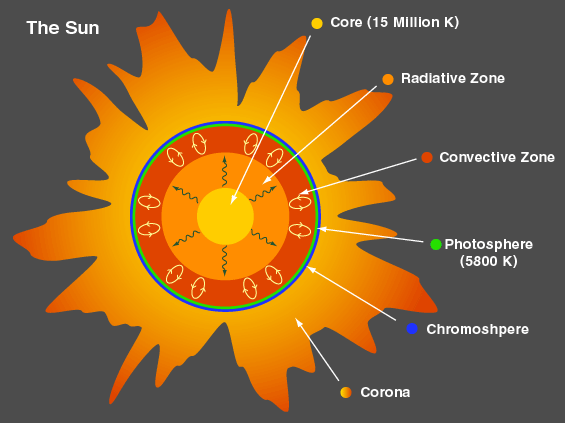The Sun's Structure and Nature
We learned the structure and nature of the Sun. We learned how energy travels from the core of the Sun to the earth. Then, we modeled the Sun itself using clay. The boys had lots of great questions about heat and gravity. They challenged me to find new ways to explain these concepts and ideas like "heat rises." Their "why" questions keep me on my toes and inspire great discussions. We talked about gravity as a law instead of a tangible object and I think they are beginning to get the idea of nuclear fusion.
The core of the Sun extends from the center to about 20–25% of the solar radius. It has a density of up to 150 g/cm³ (about 150 times the density of water) and a temperature of close to 15.7 million kelvins (K). By contrast, the Sun's surface temperature is approximately 5,800 K. Kelvin is a temperature scale designed so that zero degrees K is defined as absolute zero (at absolute zero, a hypothetical temperature, all molecular movement stops
Radiative Zone: From the core out to about 0.7 solar radii (roughly 310,000 miles), thermal radiation is the primary means of energy transfer. The temperature drops from approximately 7 million to 2 million kelvins with increasing distance from the core.
The Sun's convection zone extends from 0.7 solar radii to near the surface. In this layer, the solar plasma is not dense enough or hot enough to transfer the heat energy of the interior outward via radiation. Instead, the density of the plasma is low enough to allow convective currents to develop and move the Sun's energy outward towards its surface.
The visible surface of the Sun, the photosphere, is the layer below which the Sun becomes opaque to visible light.[93] Above the photosphere visible sunlight is free to propagate into space, and almost all of its energy escapes the Sun entirely.
The chromosphere (literally, "sphere of color") is the second of the three main layers in the Sun's atmosphere and is roughly 3,000 to 5,000 kilometers deep. The chromosphere's rosy red color is only apparent during eclipses.
The corona, Latin for 'crown' is an aura of plasma that surrounds the Sun and other stars. The Sun's corona extends millions of kilometres into space and is most easily seen during a total solar eclipse, but it is also observable with a coronagraph.


